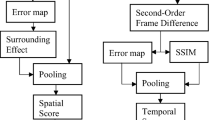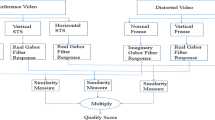Abstract
Full reference video quality assessment based on optical flow is emerging. Human Visual System (HVS) based video quality assessment algorithms are playing an important role in effectively assessing the distortions in video sequences. There exist very few video quality assessment algorithms which consider spatio-temporal distortions effectively. To address the above issues, we present an enhanced optical flow based full reference video quality algorithm which considers the orientation feature of the optical flow while computing the temporal distortions as opposed to the use of feature, minimum eigenvalue as in the state of the art. Further, it presents an interquartile range based comparative weighted closeness (INT-CWC) measure which aimed to measure the comparative dispersion of video quality scores of any two video quality assessment algorithms with DMOS scores. Here INT-CWC measure is a novel attempt. The performance of proposed scheme is evaluated using the LIVE dataset and scheme is shown to be competitive with, and even out-perform, existing video quality assessment algorithms.









Similar content being viewed by others
References
Benhur O-J et al (2014) A full reference video quality measure based on motion differences and saliency maps evaluation. In: 2014 International Conference on Computer Vision Theory and Applications (VISAPP), vol 2. IEEE
Born RT, Bradley DC (2005) Structure and function of visual area MT. Annu Rev Neurosci 28:157–189
FLOSIM (2020). [Online] http://www.iith.ac.in/lfovia/Codes/FLOSIM.zip
Gujjunoori S, Oruganti M (2020) An optical flow direction-based full reference video quality assessment algorithm. Int J High Performance Computing and Networking 16(Nos.2/3):148–159
Gunnar F (2003) Two-frame motion estimation based on polynomial expansion. Scandinavian conference on Image analysis. Springer, Berlin
Horn BKP, Schunck BG (1981) Determining optical flow. Artif Intell 17:185–203
Index (2010) Cisco Visual Networking. Global Mobile Data Traffic Forecast Update, 2009-2014, White Paper, CISCO Systems Inc 9
Kalpana S, Bovik AC (2009) Motion tuned spatio-temporal quality assessment of natural videos. IEEE Trans Image Process 19.2:335–350
Kjell B et al (2009) VQEG Validation and ITU standardization of objective perceptual video quality metrics [standards in a nutshell]. IEEE Signal Processing Magazine 26.3:96–101
Kui L et al (2010) Optical flow and principal component analysis-based motion detection in outdoor videos. EURASIP Journal on Advances in Signal Processing 2010.1:680623
Linfeng G, Meng Y (2006) What is wrong and right with MSE? Eighth IASTED. International Conference on Signal and Image Processing
Lucas BD, Kanade T (2020) An iterative image registration technique with an application to stereo vision. In: Proceedings of the 7th international joint conference on Artificial intelligence - (IJCAI’81), vol 2. Morgan Kaufmann Publishers Inc, San Francisco, pp 674–679
Manasa K, Channappayya SS (2016) An optical flow-based full reference video quality assessment algorithm. IEEE Trans Image Process 25.6:2480–2492
Nicolas S et al (2010) Assessing quality of experience of IPTV and video on demand services in real-life environments. IEEE Transactions on broadcasting 56.4:458–466
Ninassi A, Le Meur O, Le Callet P, Barba D (2009) Considering temporal variations of spatial visual distortions in video quality assess-ment. IEEE J Sel Topics Signal Process 3(2):253–265
Recommendation ITU-T P (1999) Subjective video quality assessment methods for multimedia applications. International Telecommunication Union
Recommendationitu-R BT (2002) Methodology for the subjective assessment of the quality of television pictures. International Telecommunication Union
Sagar G, Oruganti M (2018) HVS Based full reference video quality assessment based on optical flow. In: Proceedings of the international conference on pattern recognition and artificial intelligence
Seshadrinathan K, Bovik AC (2010) Motion tuned spatio-temporal quality assessment of natural videos. IEEE Trans. Image Process 19(2):335–350
Seshadrinathan K, Soundararajan R, Bovik AC, Cormack LK (2010) Study of subjective and objective quality assessment of video. IEEE Trans Image Process 19(6):1427–1441. https://doi.org/10.1109/TIP.2010.2042111
Seshadrinathan K, Soundararajan R, Bovik AC, Cormack LK (2010) A subjective study to evaluate video quality assessment algorithms. In: Rogowitz B E., Pappas T N. (eds) Human Vision and Electronic Imaging XV. https://doi.org/10.1117/12.845382, vol 7527, pp 128–137
Shyamprasad C et al (2011) Objective video quality assessment methods: a classification, review, and performance comparison. IEEE transactions on broadcasting 57.2:165–182
Video Quality Experts Group (2010) Report on the validation of video quality models for high definition video content. [Online] http://www.its.bldrdoc.gov/media/4212/vqeg_hdtv_final_report_version_2.0.zip
Wang Z, Bovik AC, Sheikh HR, Simoncelli EP (2004) Image quality assessment: From error visibility to structural similarity. IEEE Trans Image Process 13(4):600–612
Wang Z, Lu L, Bovik AC (2004) Video quality assessment based on structural distortion measurement. Signal Process Image Commun 19(2):121–132
Wang Z, Simoncelli EP, Bovik AC (2003) Multiscale structural similarity for image quality assessment. In: Proc 37th Asilomar Conf Signals, Syst Comput, vol 2, pp 1398–1402
Wikipedia contributors (2022) Interquartile range. https://en.wikipedia.org/wiki/Interquartile_range. Accessed 22 Feb 2022
Acknowledgments
The work presented in this paper is part of the project Ref: SB/FTP/ETA-0192/2014 and is financially supported by the Department of Science and Technology (DST), Government of India, New Delhi under the Fast Track Young Scientist- Engineering Science Scheme. It is gratefully acknowledged.
Author information
Authors and Affiliations
Corresponding author
Additional information
Publisher’s note
Springer Nature remains neutral with regard to jurisdictional claims in published maps and institutional affiliations.
Rights and permissions
About this article
Cite this article
Gujjunoori, S., Oruganti, M. & Pais, A.R. Enhanced optical flow-based full reference video quality assessment algorithm. Multimed Tools Appl 81, 39491–39505 (2022). https://doi.org/10.1007/s11042-022-12591-y
Received:
Revised:
Accepted:
Published:
Issue Date:
DOI: https://doi.org/10.1007/s11042-022-12591-y




